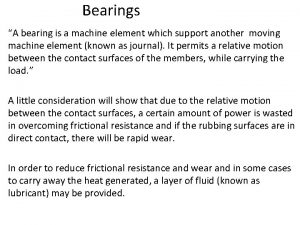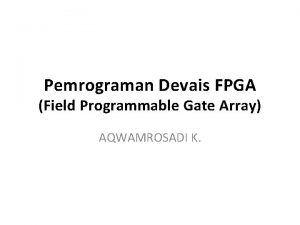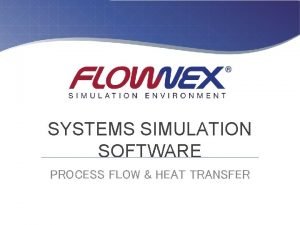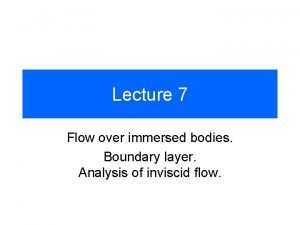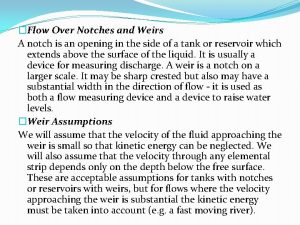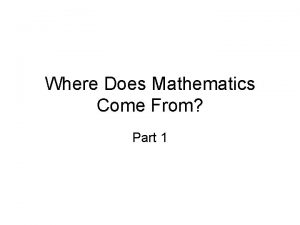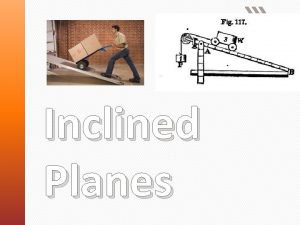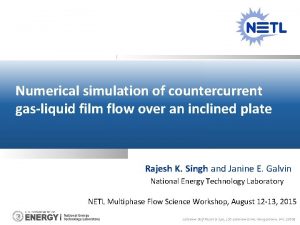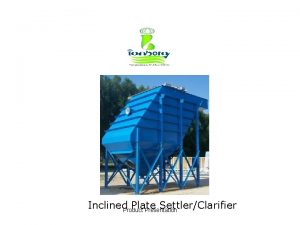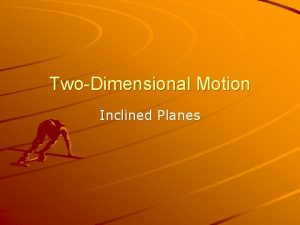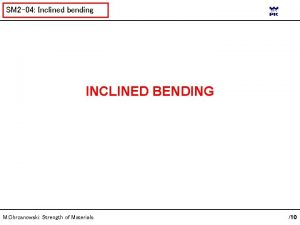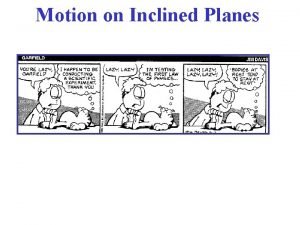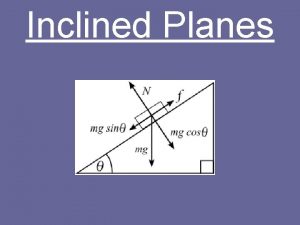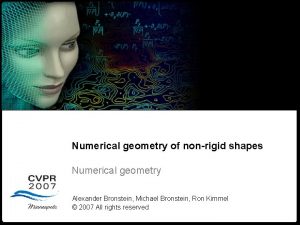Numerical Simulation of Film Flow over an Inclined



























- Slides: 27

Numerical Simulation of Film Flow over an Inclined Plate: Effects of Solvent Properties and Contact Angle Janine Carney and Rajesh Singh Multiphase Flow Science Workshop August 5 -6, 2014 Lakeview Golf Resort & Spa, Morgantown, WV

CFD Modeling of Solvent Absorption Motivation: efficiency of CO 2 absorption is closely related to local flow behavior Challenges: – Cannot model entire column focusing in on all physical phenomenon – Multi-scale approach required – Suitable closure models for interphase interactions have not been developed Intalox® Purified Gas Column 2: F ~10 m H ~30 m Lean Solvent FLEXIPAC® 1 layer height 2: ~20 cm Ultratm 1 packing 3: 25 -80 mm corrugation height 2: O(1 mm)-O(1 cm) Flue Gas to stripper Rich Solvent Source 5 film thickness 2: ~ O(0. 1 mm) Source 4 (1) Koch-Glitsch: http: //www. koch-glitsch. com/default. aspx; (2) Raynal & Royon-Lebeaud, CES, 2007; (3) Mackowiak, Fluid Dynamics of Packed Columns, Springer, 2010; (4) Xu et al. , Chem. Eng. Tech. , 2008; (5) Maiti et al. , IECR, 2006

Liquid Films Features depend upon various flow parameters and liquid properties Current Goal: study the impact of solvent properties, contact angle, flow rates, inclination angle on hydrodynamics Method: Volume of Fluid Simulations Xu et al. , Chem. Eng. Tech. , 2008 § § film thickness wetted area interfacial area flow regime

Volume of Fluid (VOF)1 Multiphase Model Governing Equations – Continuity and momentum equation of average phase Stress : turbulence neglected – Transport equation for volume fraction Interfacial forces – Force at interface resulting from surface tension Challenges – preserving a sharp boundary between immiscible fluids – computations of surface tension 1 Hirt & Nichols, J. Comput. Phys, 1981

Computation of Interfacial Force Surface tension force acts only at surface and is required to maintain equilibrium – balances inward intermolecular attractive force with outward pressure gradient force – minimizes free energy by decreasing area of interface Continuum surface force model – Brackbill et al. , J. Comput Phys. , (1992): figure 1 Other techniques are available 2 – Force at surface expressed as volume force using divergence theorem <= For two phase flow – Surface curvature is computed from local gradients in the surface normal to the interface – Effects of wall adhesion at fluid interfaces in contact with boundaries is also estimated within the CSF model The contact angle that the fluid is assumed to make with the wall is used to adjust the surface normal in cells near the wall 1 Yuan, Y. and Lee, T. R. , Contact Angle and Wetting Properties, in Surface Science Techniques , Bracco, G. , and Holst B. (eds), 2013. et al. , CES, 2010 2 Haroun

Liquid Film Down Inclined Plate z Inlet: Outlet: Plate: Sides: Top: constant velocity (through plane) pressure (0 Pa) smooth wall (no slip) smooth walls (no slip) pressure outlet (0 Pa) y x Base case 1. 05 x 10 -6 1. 05 x 10 -5 ≤ Qin ≤ 0. 003 ≤ vin ≤ 0. 03 m/s 0. 03 ≤ We. N ≤ 1. 49 23. 5 ≤ Re. N ≤ 235 kg/m 3 Physical Properties Air Water Density r (kg/m 3) 1. 185 997 Viscosity m (Pa. s) 1. 831 x 10 -5 0. 8899 x 10 -3 Surface Tension s (N/m) – 0. 0728 Static contact angle with air-steel g ( ) 70

Film flow Rivulets Computational Domain Fine mesh required to resolve rivulets 3 D view showing mesh of domain higher mesh density near plate z higher mesh density near center line Simulations conducted for pseudo-steady state t = 1 10 -5 – 1 10 -4 (Co=0. 50) Fails to correctly predict flow behavior Number of elements: 1. 15 M* (Literature: 1. 0 – 1. 5 M elements) x y Typical Run Times Case No of Cells Simulation time Wall Time No of Processor Coarse 500 K 2 s 24 hrs 32 Fine 1 1. 12 M 2 s 48 hrs 128 Fine 2 1. 37 M 2 s 48 hrs 128

Comparison with Experiments Impact of inertia on flow transition & wetted area Snapshot of Interface (e. L = 0. 5) Specific Wetted Area We=0. 02 We=0. 075 We=0. 24 We=0. 47 We=0. 76 We=1. 10 Increasing We CFD-Hoffman (2006) Exp-Hoffman (2005) Droplet Rivulet Hoffman et al. , Trans IChem. E, 2006 and Hoffman et al. , Comp. Chem. Eng. 2005 Full Film Excellent Match with Experiments

Effect of Solvent Properties on Hydrodynamics § Film thickness § Wetted area § Interfacial area § Kapitza Number only depends on fluid properties § Fixed for each solvent § Independent of flow rate § Low Ka ↔ high solvent viscosity Solvent sl ml rl (Pa-s) (kg/m 3) (N/m) l Ka Water 0. 00089 997. 0 0. 07280 8. 92578 E-07 3969. 04 30% MEA 0. 00252 1013. 0 0. 05480 2. 48766 E-06 749. 71 26. 7% AMP 0. 00270 995. 80 0. 04301 2. 71136 E-06 533. 65 40% MEA 0. 00371 1015. 3 0. 05500 3. 64917 E-06 450. 42 0. 075 m MPZ 0. 00556 1005. 3 0. 05442 5. 53489 E-06 258. 27 48. 8% MDEA 0. 00925 1016. 6 0. 04756 9. 09896 E-06 116. 60 0. 51 m MPZ 0. 01336 946. 41 0. 03437 1. 41165 E-05 49. 72 0. 41 m MPZ 0. 02348 962. 20 0. 03589 2. 44022 E-05 24. 62 0. 31 m MPZ 0. 03642 981. 31 0. 03840 3. 71137 E-05 14. 77 Flow rate computation Ql We W l l g = liquid flow rate = Weber number = Width of plate = density of liquid = l g = viscosity of liquid = surface tension of liquid = gravitational acceleration

Film Thickness for Fully Wetted Plate Fixed Q = 1. 053 10 -5 m 3/s To yield fully wetted plate Snapshot of liquid and gas distribution in the central xz-plane Longitudinal Plane Flow Solvent Plane Pfilm Air Volume Fraction of Water

Film Thickness for Fully Wetted Plate Impact of solvent properties § decreases with increase Ka Increasing viscosity Excellent agreement with Nusselt theory Flow rate:

Film Thickness for Fully Wetted Plate Impact of contact angle < 90° = 90° slv > 90° ssv 1 figure ssl § Characteristics of solid- liquid system in specific environment § Dictates the wetting behavior of solvent Two Contact Angles ( = 70 and 40 ) § Film thickness unaffected by contact angle for fully wetted plate What about for partially wetted plate? Ka-1/4 1 Yuan, Y. and Lee, T. R. , Contact Angle and Wetting Properties, in Surface Science Techniques , Bracco, G. , and Holst B. (eds), 2013.

Modified Setup for Rivulet Flow Fixed Q = 2 10 -6 m 3/sec Flo w Normalized Areas Inlet (4 2 mm 2) Interface Base Snapshot of Interface (e. L = 0. 5) Water Ka=3969 30 MEA Ka=749 48 MDEA Ka=116 31 MPZ Ka=15

Interfacial Area for Rivulet Flow Impact of inlet size and solvent property Interface at e. L = 0. 5 for 0. 31 m MPZ (Ka=15) 10 mm 25 mm 4 mm 4 mm § Developed width of rivulet remains constant at a fixed Q § Developed width only depends on Q § Slight increase in interfacial area is due to entrance effects § AIn decreases with increased Ka

Interfacial Area for Rivulet Flow Impact of inlet size and solvent property Flow rate:

Wetted/Interfacial Areas for Rivulet Flow Impact of contact angle Interface For all solvents Normalized Interfacial Area Normalized Areas For 0. 31 m MPZ (Ka=15) x Base Contact Angle § Wettability decreases with increased § Impact is greater on wetted area § Leads to increase in with increased Contact Angle

Re-normalized Interfacial Areas for Rivulet Flow Impact of contact angle A 70 = Interfacial area at = 70 Pioneering work of Zisman and coworkers 1 found 2: Low s Medium, High s § For given solid, contact angle (g) does not vary randomly with liquid § The change of cos g vs surface tension ( ) falls in a linear trend § Lower values of corresponds to smaller g Contact Angle Two regimes are evident for § Low s ( < 50 m. N/m) § Medium & High s (>50 m. N/m; 70 m. N/m) 1 Yuan, Y. and Lee, T. R. , Contact Angle and Wetting Properties, in Surface Science Techniques , Bracco, G. , and Holst B. (eds), 2013. 2 W. A. Zisman, in Contact Angle, Wettability and Adhesion: Advances in Chemistry Series, vol. 43, ed. by R. F. Gould (ACS, Washington, 1964), p. 1

Interfacial Area for Rivulet Flow Impact of contact angle Areas scale as § Interfacial Area (AIn) Low s Medium, High s m = 0. 50 = 0. 33 s < 50 m. N/m ≥ 50 m. N/m § Wetted Area (An) m = 0. 60 = 0. 45 s < 50 m. N/m ≥ 50 m. N/m

Interfacial Area for Rivulet Flow Impact of Ka at various Valid for all g Impact of Ka and

Summary & Conclusions § Multiphase flow VOF simulations can be used to explore film flow down a plate § Results presented in terms of the Kapitza number § Scaling relations were obtained to describe impact of solvent properties and contact angle on interfacial area Full Film Flow: § Film thickness decreases with increase Ka Rivulet Flow: § Wetted/Interfacial areas decrease with increased Ka § Wetted/Interfacial areas decrease with increased § § § Work in progress § § Identifying critical We for flow regime transition Impact of varying inclination angle

Disclaimer of Liability/Endorsement This work is made available by an agency of the United States Government. Neither the United States Government, the Department of Energy, the National Energy Technology Laboratory, nor any of their employees, makes any warranty, express or implied, including warranties of merchantability and fitness for a particular purpose, or assumes any legal liability or responsibility for the accuracy, completeness, or usefulness of any information, apparatus, product, or process disclosed, or represents that its use would not infringe privately owned rights. Reference herein to any specific commercial product, process, or service by trade name, trademark, manufacturer, or otherwise, does not necessarily constitute or imply its endorsement, recommendation, or favor by the United States Government, the Department of Energy, or the National Energy Technology Laboratory. The views and opinions of authors expressed herein do not necessarily state or reflect those of the United States Government, the Department of Energy, or the National Energy Technology Laboratory, and shall not be used for advertising or product endorsement purposes.

Extra Slides

Dimensionless number used

Implementation for Gas-Liquid Interfacial Force o Continuum Surface Force Model (Brackbill et al, J. Com. Phys, 1992) o surface curvature is computed from local gradients in the surface normal at the interface. o n is the surface normal, o Defined as the gradient of the volume fraction o Curvature is divergence of unit normal For Two phase the simplified equation of the force is Only two phases are present in a cell, then

Variation of Critical Weber number with Kapitza number Weber number based on hydraulic diameter of inlet DH: Inlet Hydraulic diameter We. D: Critical Weber number for droplet regime Rivulet & Film We. D Rivulet & Film Droplet Ka 0. 625

Droplet formation AMP (Ka=533) 0. 08 s 0. 17 s 0. 21 s 0. 35 s 0. 29 s MDEA (Ka=116. 6) 0. 17 s 0. 22 s 0. 27 s 0. 32 s 0. 37 s 0. 43 s

Wetted area with contact angle C: Empirical constant
 Explain wedge film and squeeze film journal bearings
Explain wedge film and squeeze film journal bearings Graclus
Graclus Apakah tujuan dari functional simulation dalam design flow
Apakah tujuan dari functional simulation dalam design flow Flownex software
Flownex software Over the mountain over the plains
Over the mountain over the plains Siach reciting the word over and over
Siach reciting the word over and over Explain how to handing over and taking over the watch
Explain how to handing over and taking over the watch To flow over and enclose
To flow over and enclose Flow around immersed bodies
Flow around immersed bodies Flow over notches
Flow over notches Pasteur point oxygen cascade
Pasteur point oxygen cascade Venturi mask 50 percent
Venturi mask 50 percent Non rebreather mask nursing considerations
Non rebreather mask nursing considerations Definition of turbulent flow
Definition of turbulent flow Internal vs external flow
Internal vs external flow Ecological succession
Ecological succession Oikos meaning
Oikos meaning Transform flow and transaction flow
Transform flow and transaction flow Transform flow and transaction flow
Transform flow and transaction flow Rotational and irrotational flow
Rotational and irrotational flow External flow and internal flow
External flow and internal flow Data flow vs control flow
Data flow vs control flow Cheese flow chart
Cheese flow chart Control flow and data flow computers
Control flow and data flow computers Transaction flow graph
Transaction flow graph Writing numerical expressions
Writing numerical expressions Numerical stroop
Numerical stroop Trapezoidal formula
Trapezoidal formula
